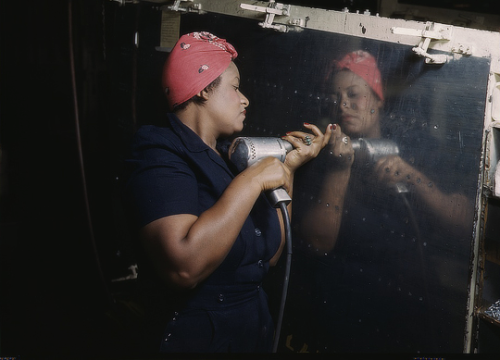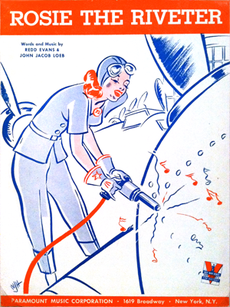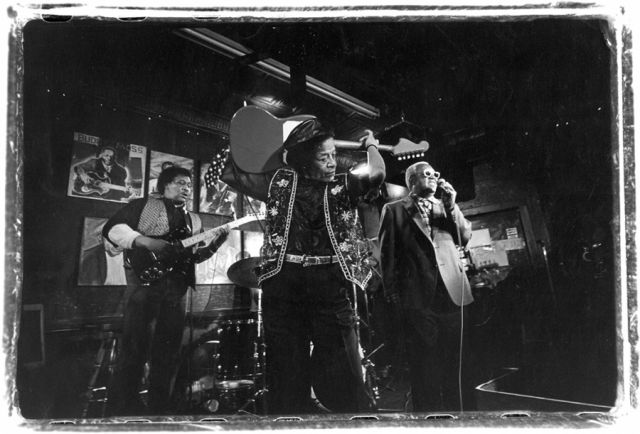#feministfriday episode 82 | Machinery
Good afternoon,
I hope you’re excited for a series of photographs of women using machinery. This started with this tumblr post:
 http://vintagegal.tumblr.com/post/142410637042/alfred-t-palmer-operating-a-hand-drill-at
http://vintagegal.tumblr.com/post/142410637042/alfred-t-palmer-operating-a-hand-drill-at
Which led me down a Rosie The Riveter based rabbit hole. I did not know before today that the WE CAN DO IT poster was not commonly known as “Rosie The Riveter” until well after the war. Here is the actual drawing of same and her excellent lipstick:
 The squeamish may want to look away now as move to an article about the women who did this work and its possible dangers. I am kind of squeamish so I’m not thinking too hard about this pullquote, that’s why you’ve got less commentary than you might usually:
The squeamish may want to look away now as move to an article about the women who did this work and its possible dangers. I am kind of squeamish so I’m not thinking too hard about this pullquote, that’s why you’ve got less commentary than you might usually:
Anderson, like the other Rosies, said that even when the work was hazardous — she lost some of her hearing because of the noise and once was sent back to work with just a Band-Aid after a co-worker accidentally drilled her ankle — she thought she was simply doing what she needed to do.
https://www.washingtonpost.com/local/real-life-rosie-the-riveter-women-share-their-stories-and-philosophy/2014/08/10/75ccdc86-20a9-11e4-8593-da634b334390_story.html
Also related to WWII, here’s a short article on the story of the women of Oak Ridge and their part in the Manhattan Project. Obviously, there’s a photo of machinery too:
 College-educated women were recruited for their skills, but not always for their specialties. One woman who had wanted to be an engineer accepted a job as a statistician, which was considered more appropriate for her gender. Unskilled local women were also necessary to the project, and these locals often found themselves applying for work at the very place which had evicted their families.
College-educated women were recruited for their skills, but not always for their specialties. One woman who had wanted to be an engineer accepted a job as a statistician, which was considered more appropriate for her gender. Unskilled local women were also necessary to the project, and these locals often found themselves applying for work at the very place which had evicted their families.
https://www.brainpickings.org/2013/03/20/the-girls-of-atomic-city/
A guitar is not technically machinery (unless it is? Thoughts, ideas welcome) but the title of this piece is “Hammer In Her Hand” and that’s close enough for me. Either way, this is a great photo and also a great article about the world’s best woman blues guitarist:
 Watkins was an instrumentalist, not a singer, which made her even more of an oddity. The images of black men playing guitar and black women cradling a microphone long ago became our ubiquitous hieroglyphs of the blues, and even now the image of a black woman playing guitar still registers as something crackling and new. It’s not that Watkins had no one to look to as she was coming up—in the thirties and forties there had been Sister Rosetta Tharpe and Memphis Minnie; in the fifties and sixties, Peggy Jones was performing as Lady Bo in Bo Diddley’s band and Odetta was modestly popular on the folk scene. But the path cut before her by these women was faint, and mostly uphill.
Watkins was an instrumentalist, not a singer, which made her even more of an oddity. The images of black men playing guitar and black women cradling a microphone long ago became our ubiquitous hieroglyphs of the blues, and even now the image of a black woman playing guitar still registers as something crackling and new. It’s not that Watkins had no one to look to as she was coming up—in the thirties and forties there had been Sister Rosetta Tharpe and Memphis Minnie; in the fifties and sixties, Peggy Jones was performing as Lady Bo in Bo Diddley’s band and Odetta was modestly popular on the folk scene. But the path cut before her by these women was faint, and mostly uphill.
http://www.oxfordamerican.org/magazine/item/767-hammer-in-her-hand
Enjoy the rest of your working day,
Alex.